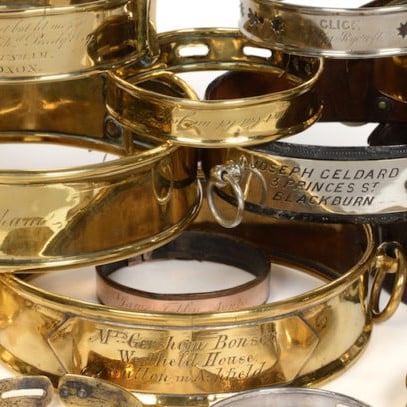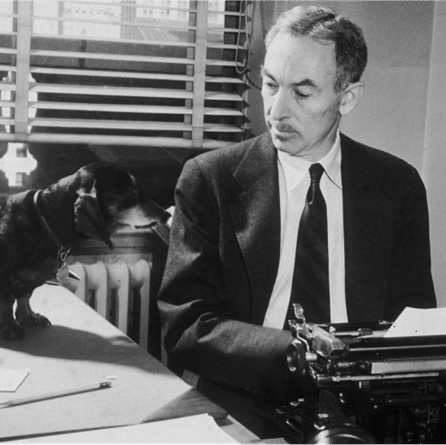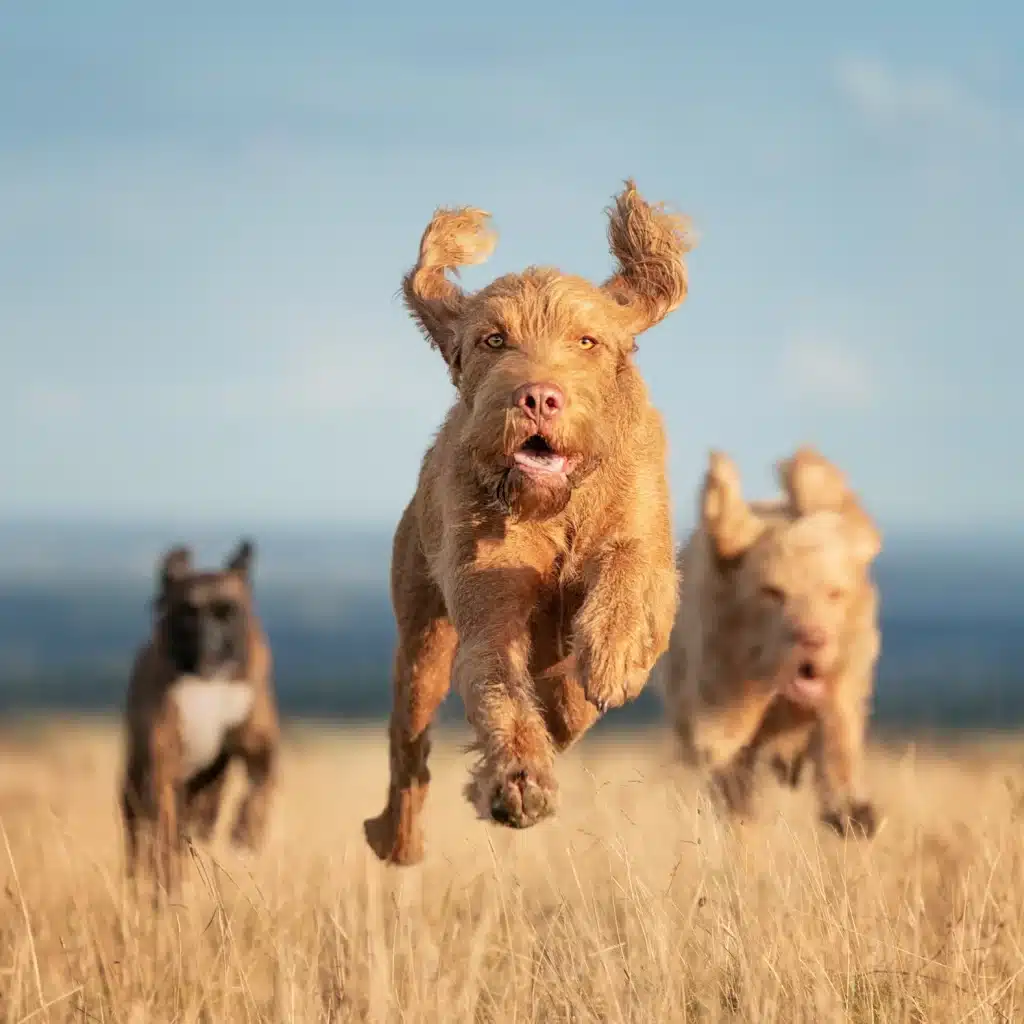Dog collars, for both ornamental and practical purposes, have been popular for millennia. Early versions were ropes tied around the dog’s neck, serving as both a collar and leash but these developed into leather dog collars, and depictions of dogs wearing them can be find for Mesopotamia and Ancient Egypt. Treasured Ancient Egyptian dogs might have their names inscribed on the collars and apart from leather ones, there were also luxury ones made of gold. In his treatise on hunting, the Greek writer and military leader Xenophon (c. 430 – 354BC) distinguished between collars, leashes and surcingles (straps around girth). The collars needed to be wide and made of a pliable material such as leather, to avoid chaffing the fur. The Ancient Greeks devised all sorts of collars for their dogs, from heavy studded ones for guard dogs to dainty leather or silver ones for spoiled pets.
The first century BC Roman author Marcus Terentius Varro suggested a special collar for guard dogs. It should be of thick leather, studded with nails. He added that leather needed to be added to the inside of the collar, so that the heads of the nails did not chafe the dog’s skin. This special collar, called a melium, would not only protect the dog wearing it from wolf attacks, but make wolves who had been injured by the sharp nails avoid all dogs in future, even those who were not wearing this protective collar. A plaster cast of the remains of small dog during the eruption of Pompeii in 79AD also preserves the contours of his buckled collar that was covered in brass studs. Roman dog collars benefitted from the Roman invention of the buckle, which made it easier to put on and take off collars, before this leather collars would be bands slipped over the dog’s head or metal ones soldered closed. Dog collars could chafe, as evidenced in one of Babrius’s fables, written in the second century AD. In the fable a fat dog meets a wolf. The wolf enquires to the dog’s size and the dog replies that a rich master feeds him. The wolf then asks why there is a bare spot on his neck. The dog replies that his fur has been rubbed off by the iron collar he wears. The wolf laughs at the dog, as he does not need the kind of luxury that would mean having one’s neck chafed with an iron collar.
During the Middle Ages, dog collars ranged from simple leather collars (with or without spikes, the former usually reserved for guard dogs), metal collars, to fabric collars (velvet, brocade, or fabric woven with gold or silver thread). Late medieval art is replete with images depicting very ornate dog collars in precious metals and luxury textiles. The accounts and inventories of aristocratic and royal owners show that these were not a mere artistic invention but that such ostentatious canine accessories could be commissioned and worn by treasured canines. On the death of the French king Charles V in 1380 all his possessions were inventoried which included: one very small blue fabric collar, embroidered with fleur de lys (the heraldic emblem of the French monarchy), three bells, and a gold buckle; thirteen silver dog collars; a silver collar with swan for the queen’s greyhound (a gift from the Duc de Berry, whose emblem was a swan); a blue velvet dog collar, with silver; a greyhound collar covered in gold studs, with a gold fleur de lys on each stud. Philip the Good, Duke of Burgundy ordered in 1420 a red velvet collar for his greyhound. The collar had two gold shields with the ducal arms and his motto moult me tarde (‘much delays me’) spelled out in little pearls.
The bill for the collar ordered in 1463 by Louis XI of France for his favourite greyhound Chier detail what a remarkable object it would have been: ‘A collar of ten segments hinged with crimped gold wire, a buckle and its tongue, four spikes in curving leaves, fifty bosses, fifty rivets, three studs with three rivets… ten large red spinels, twenty pearls, one ruby, one jacinth, one crystal panel (provided by the king)’ at the cost of 246 livres, 12 sous and 8 deniers, a tremendous amount of money. The support for all these jewels and metalwork would have been red velvet and there was a separate bill for the velvet for the collar’s lining, so that Cherie’s neck would not be chafed. Anne, Duchess of Brittany suo jure and queen consort of France, commissioned in the 1490s for both her hunting greyhounds that were kept in kennels and her own ‘little chamber dogs’ black velvet collars with gold buckles and four ermine paws (ermines were the emblem of Brittany).
In England, Henry VIII’s inventory at his death list assorted dog collars, include two of crimson velvet and cloth of gold, two collars with silver and gilt buckles with the initials H and K (for Henry and Katherine, a choice of three of his queens), a leash of a green silk and two collars of black velvet embroidered with roses (a Tudor emblem), a collar with little spikes of silver and gilt embroidered with roses and pomegranates, and one collar embroidered with greyhounds (Tudor emblem). Such luxury collars might have been helpful for Henry VIII’s dogs Cut and Ball, who had a habit of always getting lost, as they could be quickly identified. Velvet was an incredibly expensive luxury fabric in the fifteenth and sixteenth centuries, made of silk from Italy or the Middle East, it was mainly produced in Lucca and Florence. The huge cost was due not only due to the weaving process or the silk but the fact that the sought-after crimson colour came from the red dye made from the dried female Kermes insect, found inside oak trees. Apart from collars, treasured dogs might wear other accessories. Marie de Cleves, mother of Louis XII ordered five jackets (habillements) for greyhounds in 1455 and Charles VIII of France ordered a bright green wool jacket for ‘a little chamber dog. Charles VIII was rather keen on ordering accessories for his pets, he had also ordered a red and tan velvet jacket for his pet marmot.
Inscribing a dog’s name and identifying details on a collar could be helpful for all situations. During the Battle of Germantown on 4 October 1777 General Sir William Howe, Commander-in-Chief of the British forces, lost his dog who left with the wrong army. General George Washington had the dog fed and returned to the British lines two days later with the following note, written by his aide-de-camp Alexander Hamilton: ‘General Washington’s compliments to General Howe, does himself the pleasure to return him a Dog, which accidentally fell into his hands, and by the inscription on the Collar, appears to belong to General Howe’. The English poet Alexander Pope owned a succession of Great Danes, all named Bounce. A puppy was once presented to Frederick, Prince of Wales, who was living near Pope at the time in Kew Palace, with a collar with this verse inscribed on it: ‘I am his Highness’s dog at Kew. Pray tell me, sir, whose dog are you?’
Like in many things, the Victorians thought you could never go over the top with dog accessories and in 1896 a feature appeared in the Strand Magazine on the amazing stuff you could purchase for your ‘dandy dog’. The ‘Eldorado of Dandy Dogdom’ could be found at Madame Ledouble’s in Paris which not only sold dog attire for all occasions, from weddings, the theatre, yachting, to funerals, but also published a ‘canine fashion book’ so prospective clients could be inspired when purchasing outfits. You didn’t have to purchase an outfit for every dog, but sealskin waistcoats were available for dachshunds to avoid ‘their precious little stomachs’ getting wet. Barrett’s in Piccadilly was the place to go in the UK to indulge your dog-accessory mania. They sold tiny hairpins to dress poodles, gold collars, ivory collars with a black tie, silk handkerchiefs for dogs (to be ‘coquettishly stuck in Fido’s own coat-pocket), a ‘dress bracelet for a lady poodle, consisting of purple satin bow with diamond buckle, valued at £45’. Dog coats were priced between one and three guineas and brushes were available in steel, silver, buffalo-horn, and tortoiseshell. A travelling little kennel of cowhide or crocodile, with a gilt grating and a little flap to be let down when the dog was sleeping or if was too sunny was available (priced between four and ten guineas). Baskets for the drawing room could be selected, lined with satin, plush or velvet. If you had one of those new-fangled bicycles you could attach a dog basket and if walking, rubber dog boots, considered to be highly useful for all weathers and pavements, were available. To keep your pug dry in the rain, you could buy a coat with a built-in umbrella that opened and closed at the push of a button at the great cost of five guineas. If short of cash but still keen on your dog looking stylish, Victorian ladies’ journals supplied knitting and crochet patterns for readers to craft their own. Today’s retailers selling a plethora of dog accessories are merely heirs to a very long tradition!
Article by Dr Kathleen Walker-Meikle. Dr Kathleen Walker-Meikle (PhD History, UCL) is a specialist in the history of animals and medicine in the medieval and early modern period. She is the author of several books, including Medieval Pets’(Boydell & Brewer, 2021 paperback), Cats in Medieval Manuscripts (British Library Publications, 2019), Dogs in Medieval Manuscripts (British Library Publications, 2020), The Cat Book: Cats of Historical Distinction (Bloomsbury, 2015), The Dog Book: Dogs of Historical Distinction (Bloomsbury, 2014), The Horse Book: Horses of Historical Distinction (Bloomsbury, 2017).



